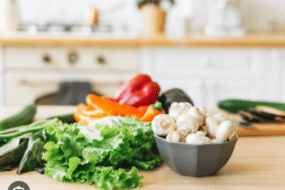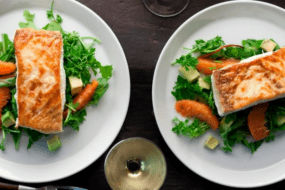
In today’s fast-paced world, it can often feel like there’s simply no time to eat healthily. Busy professionals, parents, and students frequently find themselves turning to fast food or unhealthy snacks as the easiest option when hunger strikes. However, with a little bit of preparation, healthy eating doesn’t have to be time-consuming or complicated. Meal prepping is a game-changer, providing a convenient and cost-effective way to eat nutritious meals every day, even with the busiest schedules.
Meal prep isn’t just for fitness enthusiasts or people looking to lose weight. It’s a lifestyle choice that can improve your overall well-being by giving you control over what you eat, ensuring that you get the nutrients your body needs to perform at its best. In this article, we’ll explore the basics of meal prep, offer practical tips to make it easier, and help you set up a system that works for your unique needs and lifestyle.
What is Meal Prep?
Meal prep, short for meal preparation, is the process of planning and preparing meals ahead of time, often in bulk, to make daily eating easier and healthier. Instead of scrambling to make lunch or dinner every day, meal prep allows you to cook in bulk, store meals for the week, and have healthy options ready to go at a moment’s notice. Meal prep can include anything from chopping vegetables and marinating proteins to fully cooking and storing meals in individual portions.
Why Should You Meal Prep?
- Save Time
The most obvious benefit of meal prep is time savings. Instead of spending time each day cooking or deciding what to eat, meal prepping allows you to cook in batches and free up time for other activities. On a busy day, all you have to do is reheat a prepped meal or grab something from the fridge, saving valuable time that can be used for work, family, or self-care. - Control Portions and Ingredients
When you prepare your own meals, you have full control over what goes into them. You can choose healthier ingredients, eliminate added sugars and preservatives, and adjust portion sizes to suit your needs. This is especially helpful if you’re looking to maintain a balanced diet, lose weight, or manage a medical condition like diabetes or high blood pressure. - Save Money
Eating out or buying takeout can quickly add up, especially if it becomes a daily habit. Meal prepping allows you to purchase ingredients in bulk, reducing the cost per meal. You can also avoid the temptation to spend money on expensive convenience foods or restaurant meals. - Reduce Stress
The “what’s for dinner?” question is a common stressor in many households. Meal prep takes the guesswork out of daily meal planning, making it easier to stick to a routine and reducing the pressure to make quick, often unhealthy, decisions. Knowing that your meals are already prepared can bring a sense of calm to a hectic day. - Healthy Eating Made Easy
When you meal prep, you’re setting yourself up for success in maintaining a balanced, healthy diet. With your meals already prepared, it’s much less likely that you’ll reach for unhealthy snacks or fast food when hunger strikes. You’ll also be more likely to stick to your nutrition goals because you’ve already made conscious decisions about what you’re going to eat throughout the week.
Getting Started with Meal Prep
If you’re new to meal prepping, the idea of dedicating a few hours to preparing food may seem daunting. However, it doesn’t have to be overwhelming. Here’s a step-by-step guide to help you get started.
1. Plan Your Meals
The first step in meal prepping is deciding what you want to eat for the week. Start by planning your meals for breakfast, lunch, dinner, and snacks. You can look for inspiration online, from cookbooks, or even get creative with leftovers. Make sure your meal plan includes a variety of proteins, vegetables, and grains to ensure you’re getting a well-rounded diet.
Consider the following when planning your meals:
- Balance: Include a mix of lean proteins (chicken, tofu, beans), healthy fats (avocado, nuts), and complex carbs (quinoa, sweet potatoes, brown rice).
- Variety: Don’t prep the same meals every week. Keep things exciting by switching up flavors, ingredients, and cooking methods.
- Ease: Choose meals that are relatively simple to prepare and can be made in large batches.
2. Make a Grocery List
Once you’ve decided on your meals, make a grocery list. Take inventory of what you already have in your pantry and fridge to avoid buying duplicates. Stick to your list to ensure you’re only purchasing what you need, which will also help you save money.
If you have a busy schedule, consider doing your grocery shopping online and having it delivered to your door, or utilize grocery delivery services like Instacart. This saves you even more time and ensures you’re getting exactly what you need without wandering around the store.
3. Batch Cooking
Now that you have your ingredients, it’s time to cook! Batch cooking means preparing large quantities of meals or meal components at once. For example, cook a large pot of rice or quinoa, roast several trays of vegetables, and grill or bake multiple chicken breasts at the same time. Once cooked, divide everything into individual portions so that they’re ready to grab and go when needed.
Here are some ideas for efficient batch cooking:
- Proteins: Roast a whole chicken or bake several pieces of salmon, chicken, or tofu. You can even cook different types of protein for variety throughout the week.
- Grains: Cook a big pot of rice, quinoa, or couscous, and store them in separate containers to easily reheat later.
- Vegetables: Roast, steam, or sauté vegetables in bulk. Store them in airtight containers to keep them fresh for several days.
4. Use Storage Containers
Invest in high-quality, airtight storage containers to keep your prepped meals fresh. Glass containers are ideal because they don’t stain or retain odors like plastic. Look for containers with separate compartments to keep different foods separate, or use mason jars for salads or layered meals.
Label each container with the date it was made so you can keep track of freshness. Generally, meals can be stored in the fridge for 3-4 days. If you’re preparing meals further in advance, consider freezing some portions for later use.
5. Prep Snacks
In addition to main meals, consider prepping healthy snacks that you can grab throughout the day. This could include portioned bags of nuts, pre-sliced fruits and vegetables, homemade energy bars, or hard-boiled eggs. Having healthy snacks on hand helps prevent you from reaching for junk food when you’re hungry between meals.
6. Reheat and Enjoy
When it’s time to eat, simply grab a prepped meal from the fridge, reheat it, and enjoy! Some meals may require a quick reheat in the microwave, while others may be great eaten cold (like salads or overnight oats). The beauty of meal prep is that you’ve already done the hard work – all you have to do is reheat and eat.
Tips to Make Meal Prep Even Easier
- Start Small: If you’re new to meal prep, start with prepping just one or two meals for the week and gradually increase as you become more comfortable with the process.
- Cook Once, Eat Twice: Consider making extra portions of dinner to serve as lunch the next day. This cuts down on the time and energy required to prepare multiple meals.
- Repurpose Ingredients: Use ingredients in different ways to avoid getting bored with your meals. For example, use leftover roasted vegetables in a frittata or turn leftover chicken into a wrap.
- Stay Organized: Keep your meal prep items organized in the fridge by stacking containers or using dividers to separate different foods.
- Don’t Overwhelm Yourself: Avoid the mistake of trying to prep everything at once. Focus on making sure your essentials (proteins, grains, and vegetables) are covered first, then gradually add more variety as you get used to the process.
Meal Prep Recipes to Try
Here are a few simple meal prep ideas to get you started:
- Chicken and Veggie Bowls: Cook chicken breasts, roasted sweet potatoes, and a medley of vegetables like broccoli, carrots, and bell peppers. Portion into containers and add a drizzle of olive oil or a dressing of your choice.
- Quinoa Salad: Cook quinoa and mix it with chopped cucumbers, tomatoes, red onions, and chickpeas. Toss with a lemon-tahini dressing for a fresh and nutritious meal.
- Overnight Oats: Prepare individual jars of overnight oats by mixing oats, almond milk, chia seeds, and your favorite toppings (fruit, nuts, honey). Store them in the fridge for a quick and healthy breakfast.
- Egg Muffins: Whisk eggs, spinach, tomatoes, and cheese, then bake them in a muffin tin. These make great on-the-go breakfasts or snacks.
Conclusion
Meal prep is a game-changer for anyone with a busy lifestyle who wants to eat healthy without the stress of daily cooking. By planning ahead and setting aside a few hours each week for meal prep, you’ll save time, money, and energy while ensuring that you always have healthy, delicious meals ready to go. Whether you’re meal prepping for the week or just looking for easy ways to streamline your daily routine, meal prep is a simple yet effective strategy for healthy eating on the go.






















